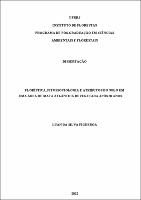Use este identificador para citar ou linkar para este item:
https://rima.ufrrj.br/jspui/handle/20.500.14407/11297| Tipo do documento: | Dissertação |
| Título: | Florística, fitossociologia e atributos do solo em uma área de Mata Atlântica revegetada após 30 anos |
| Título(s) alternativo(s): | Floristics, phytosociology and soil attributes in an Atlantic Forest area revegetated after 30 years |
| Autor(es): | Figueroa, Luan da Silva |
| Orientador(a): | Faria, Sérgio Miana de |
| Primeiro membro da banca: | Faria, Sergio Miana de |
| Segundo membro da banca: | Costa, Marcelo Sousa da |
| Terceiro membro da banca: | Chaer, Guilherme Montandon |
| Palavras-chave: | Resflorestamento;Mata atlântica;Solo florestal |
| Área(s) do CNPq: | Recursos Florestais e Engenharia Florestal |
| Idioma: | por |
| Data do documento: | 5-Set-2022 |
| Editor: | Universidade Federal Rural do Rio de Janeiro |
| Sigla da instituição: | UFRRJ |
| Departamento: | Instituto de Florestas |
| Programa: | Programa de Pós-Graduação em Ciências Ambientais e Florestais |
| Citação: | FIGUEROA, Luan da Silva. Florística, fitossociologia e atributos do solo em uma área de Mata Atlântica revegetada após 30 anos. 2022. 80 f. Dissertação (Mestrado em Ciências Ambientais e Florestais) - Instituto de Florestas, Universidade Federal Rural do Rio de Janeiro, Seropédica, 2022. |
| Resumo: | Este estudo foi realizado em uma área de restauração florestal no Bioma Mata Atlântica localizada no município do Rio de Janeiro – RJ. Teve como objetivos a caracterização da vegetação, análise da estrutura da comunidade arbórea e regenerante, caracterização do banco de sementes, estoque e nutrientes da serapilheira, análise química do solo e dos microrganismos presentes e sua atividade, de forma a estabelecer critérios adequados para seu monitoramento e manejo. Para o estudo foi empregado o método de amostragem por parcelas de área fixa, distribuídas de forma sistemática. Os dados foram coletados em nove parcelas amostrais de 100 m2, alocadas na área do reflorestamento, oito parcelas em área de floresta secundária preservada utilizada como referência positiva, e duas parcelas em área degradada como referência negativa. No reflorestamento e na floresta secundária foram coletados dados da vegetação arbórea adulta e regenerante, serapilheira, banco de semente e solo para análises química e microbiológica. Na área degradada foram coletados solos para caracterização do banco de sementes, análise química e microbiológica. No levantamento da composição florística do reflorestamento foram constatados 103 indivíduos, distribuídos em 33 espécies, obtendo-se um índice de diversidade de Shannon (H') de 3,07 e Pielou (J’) de 0,83. O reflorestamento apresentou maior diversidade do estrato regenerante em relação a área de referência. Houve influência da profundidade na análise química solo, indicando influência positiva da serapilheira no piso florestal. Para as variáveis microbiológicas, não houve diferença significativa entre os tratamentos para os parâmetros biomassa microbiana e respiração basal; no entanto, o reflorestamento apresentou diferença significativa maior pelo teste de Tukey a 95% em comparação com as outras áreas para a variável hidrólise de FDA, que mediu a atividade enzimática entre os ambientes. |
| Abstract: | This study was carried out in a forest restoration area in the Atlantic Forest Biome located in the municipality of Rio de Janeiro - RJ. It aimed to characterize the vegetation, analyze the structure of the tree and regenerating community, characterize the seed bank, litter stock and nutrients, chemical analysis of the soil and the microorganisms present and their activity, in order to establish adequate criteria for their monitoring. and handling. For the study, the method of sampling by plots of fixed area, systematically distributed, was used. Data were collected in nine sample plots of 100 m2, allocated in the reforestation area, eight plots in a preserved secondary forest area used as a positive reference, and two plots in a degraded area as a negative reference. In reforestation and secondary forest, data were collected from adult and regenerating tree vegetation, litter, seed bank and soil for chemical and microbiological analysis. In the degraded area, soils were collected for characterization of the seed bank, chemical and microbiological analysis. In the survey of the floristic composition of the reforestation, 103 individuals were found, distributed in 33 species, obtaining a diversity index of Shannon (H') of 3.07 and Pielou (J') of 0.83. The reforestation showed greater diversity of the regenerating stratum in relation to the reference area. There was influence of depth in the soil chemical analysis, indicating a positive influence of litter on the forest floor. For microbiological variables, there was no significant difference between treatments for microbial biomass and basal respiration parameters; however, the reforestation showed a significantly greater difference by the Tukey test at 95% compared to the other areas for the ADF hydrolysis variable, which measured enzymatic activity between environments. |
| URI: | https://rima.ufrrj.br/jspui/handle/20.500.14407/11297 |
| Aparece nas coleções: | Mestrado em Ciências Ambientais e Florestais |
Se for cadastrado no RIMA, poderá receber informações por email.
Se ainda não tem uma conta, cadastre-se aqui!
Arquivos associados a este item:
| Arquivo | Descrição | Tamanho | Formato | |
|---|---|---|---|---|
| 2022 - Luan da Silva Figueroa.Pdf | 2022 - Luan da Silva Figueroa | 2.86 MB | Adobe PDF |  Abrir |
Os itens no repositório estão protegidos por copyright, com todos os direitos reservados, salvo quando é indicado o contrário.

